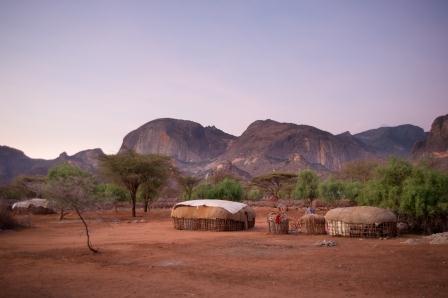
Huts for visitors in Ngurunit at the base of the Mathews Range in Laisamis District (photo by David DuChemin)
In the morning I woke early, anxious to be back on the road and on our way to Loiyangalani. Poor Kura, Omar and Semeji had been up late, talking with Joseph. I hated to wake them up but Kura was great, as usual. “It’s okay, Mama Rungu, I agree, we should leave now.”
“Okay, Kura, I’ll drive, and Baba Rungu can ride shotgun. You sleep while we drive.”
It was wonderful to be driving at sunrise through the stunning valleys of the Mathews Range. The mountains were dark monoliths that turned to gray and then purple as the sun drenched the sides of its steep rocky flanks. The trees were teeming with birds – flycatchers, bee-eaters and rollers. We were treated to the sight of not one but two pairs of African hoopoes, one of the most stunning birds on the continent.
We made a brief stop in South Horr and had breakfast at the Samburu Sports Club. Stackwel had plenty of supplies in camp thanks to the presence of the workers from the Lake Turkana Wind Project. We were thrilled when he offered us a fresh press of coffee.
At the “junction” Kura took over driving with Semeji in the passenger seat, AK at the ready. This was the insecure section of our journey but this time the road was not deserted. We came upon huge herds of cattle, goats and camels – all making their way towards the areas that had received the most rain from the unusual cloudburst. I have never seen so many livestock in one place in northern Kenya. Men, boys and young girls flanked large herds that considerably slowed our passage on the road. It also made me nervous. Where there are huge herds there are also livestock rustlers. Kura too, was on full alert.
As if to bear out this premonition, Kura and I suddenly heard a pop, pop on the southern side of the road. Kura floored it.
“Did you hear that, Mama Rungu?”
“Yes, Kura, sounds like a tire – what is it?”
“Gunshots, Mama Rungu.”
Neither Doug, Semeji or Omar had heard the sound. But attuned to its tenor, Kura and I heard it again. Pop, pop. Gumps was hitting every gully and hole at full speed. We bounced around the road at a bone-shattering speed. I looked out on the ridge and saw two men silhouetted against the sky. They were holding guns.
“Did you see them, Kura?”
“Yes, Mama Rungu.”
“Who are they?”
“I don’t know, maybe security for the wind power people, maybe cattle rustlers, maybe people killing wildlife for food.”
Semeji had his AK cocked but he sat in the front dazed.
“Kura, what’s wrong with Semeji?”
“I don’t know Mama Rungu, he is sick. He has headache, maybe malaria.”
Ok, great. We’re driving through a valley teaming with livestock. We’ve just heard gunshots and our security man is dazed and ill. If I was with safari clients I would tell them that you have to pay extra for this excitement. The adrenalin was still pumping as we reached the flat expanse of volcanic rock in the approach to Loiyangalani.
This was not what I wanted Doug to see. He was here as one of the few people to come to the north and see our work, to meet some of our business owners and Village Mentors. We have a model of economic empowerment that is appropriate and innovative for the semi-arid rural regions of Africa. What I want Doug to see is what is at the heart of our work – the people. The innovation in our model comes from its emphasis on local leadership and the transfer of knowledge in ways that empower. That is what we will focus on for our time in the desert oasis town of Loiyangalani.
